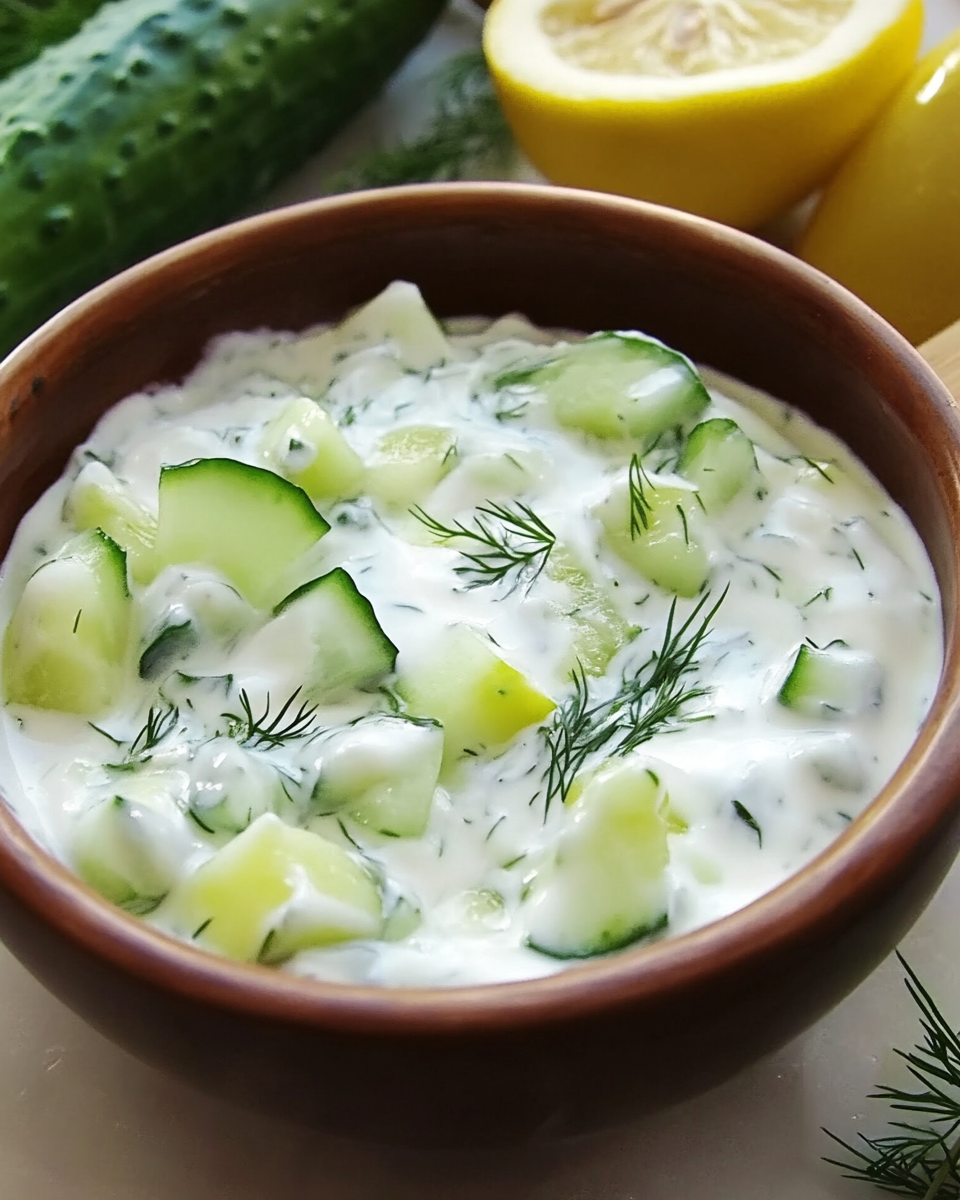Tzatziki is the ultimate refreshing dip that combines the coolness of cucumber with the creamy richness of Greek yogurt. With a hint of garlic, dill, and lemon juice, it’s the perfect accompaniment to grilled meats, pita, or even just a veggie platter. This sauce brings the authentic flavors of Greece to your table and makes for a light, healthy snack or appetizer.
Whether you’re hosting a summer party or enjoying a casual dinner, Tzatziki offers the perfect balance of flavor and texture. Quick to prepare and even better when chilled, this dip is a go-to for anyone looking to add something fresh and tasty to their spread.
Full Recipe:
-
1 cucumber, peeled and grated
-
1 cup plain Greek yogurt
-
1 tablespoon olive oil
-
1 tablespoon fresh dill, chopped
-
1 tablespoon lemon juice
-
1 garlic clove, minced
-
Salt and pepper, to taste
Directions:
-
Grate the cucumber and place it in a clean towel to squeeze out excess moisture.
-
In a mixing bowl, combine the Greek yogurt, olive oil, dill, lemon juice, and garlic.
-
Add the grated cucumber to the yogurt mixture and stir until well combined.
-
Season with salt and pepper to taste. Mix again.
-
Chill in the refrigerator for at least 30 minutes to let the flavors meld.
Prep Time: 10 minutes | Total Time: 10 minutes
Kcal: 100 kcal | Servings: 4 servings
Tzatziki Cucumber Dipping Sauce: A Greek Classic
Tzatziki sauce is a quintessential element of Greek cuisine that has transcended regional boundaries, gaining popularity across the world. This creamy, refreshing dip, made with Greek yogurt and cucumber, offers a cooling effect with a delightful blend of herbs, garlic, and lemon. Whether enjoyed as a side dish, appetizer, or condiment, tzatziki brings a light, tangy flavor that enhances any meal. In this article, we explore the origins, variations, health benefits, and tips for preparing the perfect tzatziki.
The History of Tzatziki Sauce
Tzatziki has deep roots in Mediterranean and Middle Eastern culinary traditions. Its origins can be traced to Turkey, where it is known as “Cacık,” a similar yogurt-based dish with cucumber and garlic. The Greeks adopted this dish, evolving it into what we now recognize as tzatziki. The name “tzatziki” comes from the Turkish word “cacık,” and the dish has been an integral part of Greek cuisine for centuries. Historically, tzatziki was enjoyed as a side dish with grilled meats, particularly lamb and chicken, and often paired with pita bread.
Its popularity has spread throughout the Mediterranean region, where variations of tzatziki can be found in countries such as Turkey, the Balkans, and the Middle East. Despite slight regional differences, the key ingredients—yogurt, cucumber, garlic, and herbs—remain consistent.
The Ingredients That Make Tzatziki Special
The beauty of tzatziki lies in its simplicity. The base of the sauce is Greek yogurt, known for its thick and creamy texture. Unlike regular yogurt, Greek yogurt has a higher protein content and less water, making it perfect for creating a rich dip that holds its shape. The cucumber adds a refreshing crunch and lightness to the sauce, balancing the creaminess of the yogurt.
Garlic, lemon juice, and fresh herbs such as dill or mint provide depth of flavor, while olive oil contributes a smooth finish. These ingredients come together to create a perfectly balanced sauce that complements a wide variety of dishes.
Health Benefits of Tzatziki
Not only is tzatziki a delicious addition to any meal, but it also comes with a range of health benefits. The primary ingredient, Greek yogurt, is rich in probiotics, which are beneficial bacteria that support gut health. Probiotics help maintain a healthy balance of good bacteria in the digestive system, contributing to improved digestion and a stronger immune system.
The cucumber in tzatziki is high in water content, making it a hydrating ingredient that is low in calories. This makes tzatziki a great option for those looking to maintain a healthy weight or stay hydrated. The fresh herbs like dill or mint also offer antioxidants and anti-inflammatory properties, which contribute to overall well-being.
Furthermore, tzatziki is a great source of protein and calcium, thanks to the Greek yogurt. These nutrients play a vital role in maintaining strong bones and supporting muscle function. For those following a vegetarian or plant-based diet, tzatziki can be a valuable addition to meals, providing essential nutrients in a light, refreshing format.
How to Use Tzatziki
Tzatziki is an incredibly versatile dip that can be used in a variety of ways. Traditionally, it is served as a side dish with grilled meats, particularly lamb, chicken, and pork. The cool, creamy texture of tzatziki pairs perfectly with the smoky flavor of grilled meat, offering a refreshing contrast.
Aside from its traditional use as a meat accompaniment, tzatziki is also perfect for dipping pita bread, raw vegetables, or crispy fries. Its versatility extends to being used as a condiment for wraps, sandwiches, and burgers, where its creamy texture adds moisture and flavor to the dish.
In addition to its savory applications, tzatziki can also be used as a dressing for salads. When thinned with a little olive oil and lemon juice, tzatziki transforms into a tangy salad dressing that complements fresh greens and vegetables.
Variations of Tzatziki
While the classic recipe for tzatziki remains beloved worldwide, various regions have their own takes on the dish. In Turkey, for instance, tzatziki (or cacık) is often served with a more liquid consistency, allowing it to be used as a soup or a more diluted dip. In some parts of the Balkans, tzatziki might be made with the addition of walnuts or even a little vinegar for added acidity.
The herbs in tzatziki can also vary depending on personal taste. While dill is the most common herb used, mint is a popular alternative that adds a refreshing, aromatic twist to the sauce. Some recipes may incorporate a small amount of feta cheese, which imparts an extra layer of richness and flavor to the dip.
For a spicier version, some variations of tzatziki include a pinch of cayenne pepper or red pepper flakes, providing a subtle heat that contrasts nicely with the cooling properties of the cucumber and yogurt.
Tips for Making the Perfect Tzatziki
Making the perfect tzatziki requires a balance of flavors and textures. Here are some tips to help you achieve the best results:
-
Use Thick Greek Yogurt: The key to a creamy tzatziki is using thick, full-fat Greek yogurt. If you prefer a lighter version, you can use non-fat or low-fat yogurt, but the texture and richness will differ.
-
Grate the Cucumber: Instead of chopping the cucumber, grate it finely. This will release more water, which can be squeezed out, ensuring the tzatziki is thick and not watery.
-
Let it Chill: For the best flavor, allow the tzatziki to chill in the refrigerator for at least 30 minutes before serving. This gives the flavors time to meld and become more pronounced.
-
Don’t Skip the Garlic: Garlic is essential to tzatziki, as it provides the dip with its signature punch. Be careful not to overpower the dip with too much garlic, as a little goes a long way.
-
Adjust the Lemon Juice: Lemon juice adds brightness and acidity to tzatziki. Adjust the amount according to your preference—some may prefer a more tangy flavor, while others may want it more subtle.
-
Experiment with Herbs: While dill is traditional, don’t hesitate to experiment with other herbs like mint, parsley, or even a small amount of cilantro for a unique twist.
Conclusion
Tzatziki is much more than just a dipping sauce—it’s a refreshing, flavorful accompaniment that brings a taste of Greece to your table. Whether you’re using it as a condiment for grilled meats, a dip for veggies, or a dressing for salads, tzatziki never fails to deliver a cool, creamy, and tangy flavor. Its simple ingredients not only make it easy to prepare, but they also contribute a wealth of health benefits, including probiotics, antioxidants, and hydration.
By following a few simple tips and adjusting the ingredients to suit your taste, you can create a homemade tzatziki that will be a hit at any gathering. With its rich history, versatility, and fresh flavors, tzatziki continues to be a beloved staple in Mediterranean cuisine and beyond.
Tzatziki is perfect for anyone looking to add a little extra flavor to their meals, whether for a summer barbecue or a weeknight dinner. Its easy preparation and healthy ingredients make it a go-to choice for anyone seeking a delicious and nutritious dip. So, next time you’re in the mood for a refreshing treat, make sure to whip up a batch of tzatziki and enjoy the cooling comfort of this Greek classic.






